TABLE OF CONTENTS
Growing cannabis can be a rewarding and fulfilling experience, but it can also be a challenging one.
In this article, we will walk you through the entire process of cannabis cultivation, from the beginning with seeds or clones to all the growing stages and finish with how to cure the harvested buds.
Best Strains for Beginner Home Growers
When it comes to choosing strains to grow, there are many different factors to consider. For beginner home growers, it's best to start with strains that are easy to grow, have a relatively short flowering time, and are resistant to common pests and diseases. Here are some of the best strains for beginner home growers:
- Northern Lights – This classic strain is a staple in the cannabis world and is known for its fast flowering time and high yields. Northern Lights is a hybrid strain that is easy to grow and is resistant to pests and diseases.
- White Widow – White Widow is another classic strain that is known for its fast flowering time, high yields, and resistance to pests and diseases. This hybrid strain is a good choice for beginner home growers, as it is relatively easy to grow and produces large, sticky buds.
- Blue Dream – Blue Dream is a popular hybrid strain that is known for its sweet, fruity aroma and high yields. This strain is easy to grow and is resistant to pests and diseases, making it a good choice for beginner home growers.
- Bubblegum – Bubblegum is a sweet and fruity strain that is known for its high yields and fast flowering time. This hybrid strain is easy to grow and is resistant to pests and diseases, making it a great choice for beginner home growers.
Growing Your Cannabis
Once you've chosen your seeds or clones, it's time to start growing your cannabis. Whether you're growing in soil or hydroponic systems, the basic growing process is the same. Here's an overview of what you'll need to do:
- Prepare your grow area – This includes setting up lights, fans, and other equipment, as well as preparing your soil or hydroponic system.
- Germinate your seeds or plant your clones – This is the stage where you get your seeds or clones started. If you're growing from seeds, you'll need to soak them in water and then place them in soil or a hydroponic system. If you're growing from clones, you'll simply need to plant them in soil or hydroponic system.
- Vegetative stage – During the vegetative stage, your plants will grow leaves and stems, and you'll want to provide them with adequate light and nutrients to encourage growth.
- Flowering stage – Once your plants have reached a certain size, they will start to flower. This is the stage where you'll start to see buds form on your plants. You'll want to reduce the amount of light your plants receive each day to trigger the flowering stage.
- Trimming – Trimming is an important step in the growing process, as it helps to improve the appearance and quality of your buds. You'll want to trim away any large fan leaves, as well as any small leaves that are close to the buds. This will also help to improve air flow and prevent mold or mildew from forming on your buds.
- Harvesting – Harvesting is the moment you've been waiting for! When your buds are ready to be harvested, they will be dense, sticky, and covered in trichomes. You'll want to cut your plants down at the base, and then hang them upside down to dry.
- Drying – Drying is an important step in the curing process, as it allows the moisture in the buds to evaporate. You'll want to hang your buds in a well-ventilated area with low humidity, and check them regularly to ensure that they are drying evenly.
- Curing – Curing is the final step in the growing process, and it is crucial to the quality and taste of your buds. During the curing process, the buds will continue to mature and develop their flavor and potency. You'll want to store your buds in airtight containers in a cool, dark place, and check them regularly to ensure that they are curing properly.
How Long Does It Take to Grow Weed Indoors?
Weed plants grow at different speeds, but usually, plants can grow fully within a few months. Generally, cannabis plants take about three to four months to mature, although autoflowering strains can grow in under three months.
Growing Weed Indoors for Beginners
Cannabis plants require proper care and maintenance from seed to harvest.
Here’s what you’ll need to grow indoor marijuana.
Seeds and Clones
Will you be starting your garden with seeds or clones? For beginners, we recommend using feminized seeds over regular seeds since feminized ones only produce flowering plants, not male pollinating plants. Autoflowering strains can be a good option, too.
If you’d rather skip the germination phase, you can start your garden with a cannabis clone derived from a healthy, vegetative mother plant. Cannabis clones are branch cuttings that feature the same genetics as their mother plant.
Grow Space Location
Cannabis plants can be grown in any free space in your home. We recommend investing in a small grow tent to provide your plants with a climate-controlled grow space to thrive. Grow tents come in various shapes to accommodate small or large gardens.
Lighting
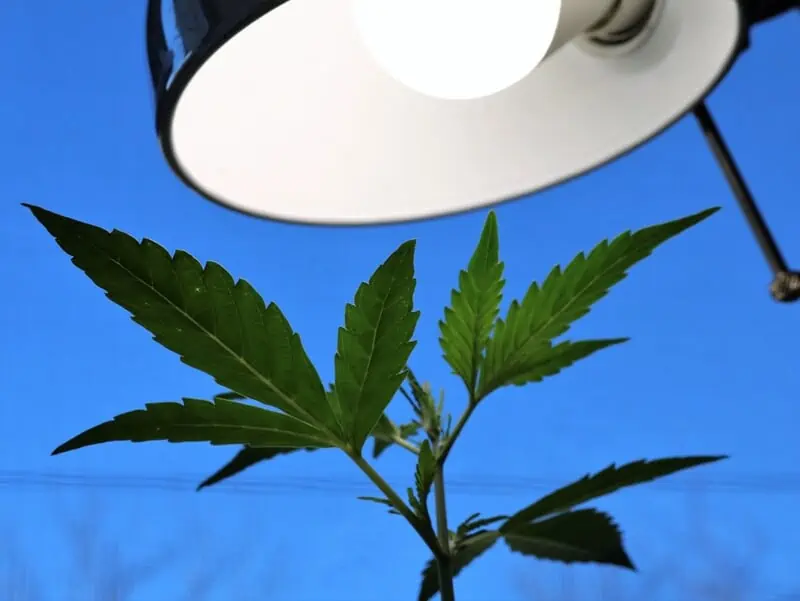
Growing marijuana indoors means you need to provide your plants with plenty of light. We recommend light-emitting diode (LED) lights over fluorescent or HID grow lights. While LEDs may have a slightly higher upfront cost, they run cool, use less heat, provide energy savings, and have a higher light intensity.
Air Circulation and Ventilation
A small oscillating fan in your grow tent or grow room can provide your plants with the right amount of air flow to reduce humidity and strengthen their structure. Air circulation and an intake and exhaust fan can bring in the fresh air and take out stale air.
Growing Medium
We recommend using soil over a soilless medium in a hydroponic system for beginners. Pre-made soil mixes with organic nutrients are an excellent way to start your garden. Soil-based systems can be more affordable and require less maintenance than hydroponic systems.
Container
Cannabis containers should provide proper drainage, space for roots, and air circulation. Fabric pots are great options for beginners. A one-gallon pot should be good for a young plant. Transfer to a larger container size as needed.
Nutrients
Beginners can feed their plants nutrient solutions from reputable brands based on the manufacturer’s feeding schedule. We recommend feeding the plant 25 percent of the recommended amount and increasing it as needed. Plant nutrients are available in grow and bloom versions for use during the vegetative and flowering stage.
Cannabis Plant Growth Stages
Growing weed indoors successfully requires understanding the plant’s different growth stages.
Here is what to expect during its life cycle.
Germination
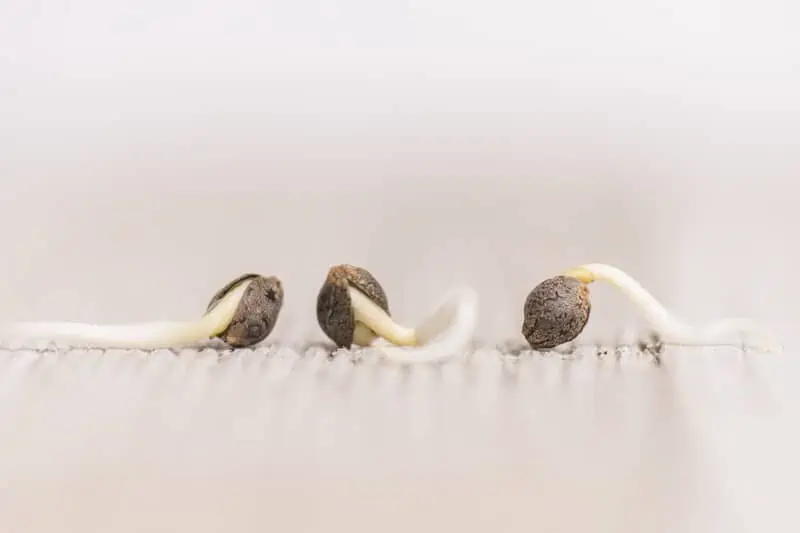
If starting from seeds, germination can be accomplished using the paper towel method. Cannabis seeds can be placed between two plates and moist paper towels. Seeds begin to sprout within a few days in this environment.
Vegetative Stage
During the vegetative stage, cannabis plants focus their growth on their leaves and branches and need at least 18 hours of light and 6 hours of darkness. A timer can help you keep track of light cycles. Temperatures should be between 70 and 85º F. Plants should be watered when the top inch or two of the soil feels dry.
Flowering Stage
During the flowering stage, plants will develop flower buds and require 12 hours of light and 12 hours of darkness. Regularly prune the plant to ensure every bud site gets enough light to grow. During the final week or two, growers may flush the nutrients from their plants by only feeding them water.
Harvest
The perfect time to harvest your plants is when about 50 percent of the trichomes have turned an amber color. When it’s time to harvest, remove the branches from the main stem using sharp shears and prune the fan leaves.
Drying
Drying the cannabis bud branches usually occurs in a dark and cool area with temperatures between 60 and 70º F and relative humidity (RH) of 50%. Branches can be hung from a wire or string to dry. When the branch breaks off with an audible snap, the buds have dried properly.
Curing
Once your buds have dried, it’s time to place them in an airtight glass jar and cure cannabis buds for a few weeks or months. Open the jar’s lid every day for about 10 minutes to release stale air and introduce fresh air into the jar. Curing times depend on your individual preference.
Learn how to start a pot of cannabis. Starting a cannabis garden is one of the most exciting gardening activities you can legally do in many states (some restrictions apply).
If you want to start growing cannabis in a pot or container, here are seven easy steps to get your indoor or outdoor garden started.
7 Steps to Start a Pot of Cannabis
Step 1: Source Healthy Cannabis Seeds
One of the first steps is to find healthy cannabis seeds from licensed dispensaries or reputable seed banks that ship to your location. If you are starting with cannabis seeds, you will likely run across a few seed types available in many strain varieties.
You can start with a cannabis clone (a healthy cutting from a mother vegetative plant) and skip the germination phase.
Regular Seeds
Regular cannabis seeds have a 50-50 chance of producing male or female cannabis plants. These photoperiod plants begin flowering when their lighting cycle changes to 12 hours of light and 12 hours of darkness from 18 hours of light and 6 hours of darkness.
If your regular seeds are growing outdoors, they can begin flowering after the autumnal equinox when the daylight starts to get shorter.
Feminized Seeds
Feminized cannabis seeds are genetically manipulated to produce only female flowering plants. Like regular cannabis seeds, plants from feminized seeds will begin flowering when the lighting cycle turns to 12 hours of light and 12 hours of darkness or when the days become shorter outdoors.
Autoflowering
Autoflowering cannabis seeds do not require changing the lighting cycle like photoperiod plants to begin flowering. Instead, these plants start flowering after a certain period of time, regardless of light or other environmental factors. Autoflowering plants grow smaller and faster, suitable for first-time growers.
Step 2: Invest in Weed Grow Lights
If you plan on growing indoors or want to provide supplementary lighting for your greenhouse garden, you need the best cannabis grow lights. The success of your harvest can depend on the amount of light you give your plant. Providing the right light intensity and coverage to your canopy is critical to producing high yields without stressing the plants.
During the seedling stage, cannabis plants do not need strong light intensity. If growing outdoors, we recommend starting your seeds indoors until they are strong enough to grow outdoors.
Here are a few grow light options to consider.
Fluorescent
Fluorescent lights, like complex fluorescent bulbs (CFLs) and T5s, are affordable and effective for growing a small garden and during the seedling stage. They use less energy than the other options and do not emit as much heat, although they do not yield as much as other grow lights.
High-Intensity Discharge (HID)
High-intensity discharge grow lights are popular for commercial growing due to their light intensity and power. Due to the higher heat output, growers will need an exhaust fan to control the heat. Generally, growers use metal halide (MH) bulbs for the vegetative stage and high-pressure sodium (HPS) bulbs when the plants begin flowering, although HPS bulbs can work for both stages.
Light-Emitting Diode (LED)
Light-emitting diode (LED) lights are one of the most effective grow lights on the market. Many grow light panels feature a full spectrum of light for both the vegetative and the flowering stages. LED lights are much more energy-efficient than HIDs and produce less heat for better temperature control. While they can be pricier, they can end up saving you on energy bills in the long run.
Step 3: Choose a Suitable Pot/Container for Marijuana
When choosing a cannabis container, there are many sizes and options. Growers can start with something as small as a solo cup for their seedlings and switch to a larger fabric pot as the plant grows. Your pot must properly drain to avoid excess moisture that can lead to root rot. Smart Pots are an excellent option if you are not growing outside in a garden bed.
Step 4: Choose a Grow Medium
Grow mediums are essential for supporting the plant, providing it with water and nutrients, and giving the roots the space and oxygen they need.
Soil
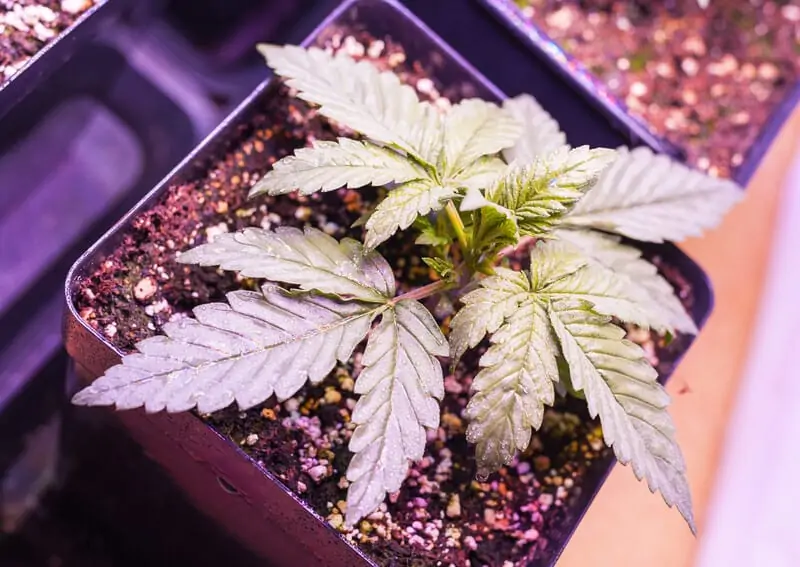
Growing cannabis in soil is one of the best ways for beginner growers to start as long as the soil has the appropriate structure to retain moisture and provide oxygen to the roots.
You may need to incorporate certain materials like perlite or coco coir to create a well aerated mixture to prevent mold. Learn more about buying or creating the best soil for cannabis plants with our blog post.
Hydroponics
If you are a beginner, hydroponics is not recommended due to the complexity of the systems compared to soil-based gardens, although many can quickly catch on. In a hydroponics setup, the plant's roots are supported by an inert grow medium, and the roots are exposed to a nutrient and water solution.
Different hydroponics setups include deep water culture, ebb and flow, drip irrigation, and aeroponics. You can also choose from various substrates, including Rockwool, perlite, vermiculite, and hydroton clay pebbles.
Step 5: Get Nutrients
Cannabis plants need macro and micronutrients at different concentrations during the vegetative and flowering stages. Choose nutrients from various nutrient brands available in vegetative and flowering formulas for each stage.
If you're buying your nutrients, we recommend using about half the manufacturer’s recommended dose of nutrients and going up or down as needed without stressing the plant. Excessive nutrients can stress and damage the plant.
You can also make your own organic, living soil mixture with potting soil, perlite, coco fiber, and other natural ingredients such as bat guano, fish meal, bone meal, earthworm castings, alfalfa meal, and more.
Step 6: Set-Up Ventilation
Whether you grow indoors or outdoors, you need the proper ventilation to deter mold, strengthen your plants’ structure, provide your crop with fresh air, and remove the stale air. We recommend setting up an exhaust fan in your indoor grow space or grow tent to continually remove stale air and passively pump fresh air.
Step 7: Find a Good Water Supply
If you want to grow healthy cannabis plants, you need a good water source. While tap water can work, in some cases, you want to ensure that there is not an excess of minerals, also known as “hard water,” which can affect plant growth.
Cannabis plants prefer water with a pH of around 6-7 when grown in soil. If your water is outside the optimal pH zone, you can use various methods to adjust the pH.
Preparing to Sell or Smoke Your Cannabis
Once your buds have been cured, they are ready to be sold or smoked. If you're planning to sell your buds, you'll want to make sure that they are properly packaged and labeled. You'll also want to test the potency and quality of your buds to ensure that they are of the highest quality.
If you're planning to smoke your buds, you'll want to grind them up and pack a bowl or roll a joint. When smoking cannabis, it's important to remember to start slow and only consume small amounts at a time, especially if you're a beginner.
Growing cannabis is a great way to produce high-quality buds that are free from chemicals and pesticides. Whether you're a beginner or an experienced grower, it's important to understand each step in the growing process and to choose the right strains for your grow. With the right approach and a little patience, you'll be well on your way to producing high-quality buds that you can be proud of.
Overview of How To Grow Weed-Step-By-Step
If you want to become a cannabis growing expert, there are a few factors you must consider, including where you plan to grow your weed, the types of strains you plan to grow, whether you want a soil-based or soil-less method, and so much more.
Ultimately, every part of your growing environment and your cultivation practices affects the size of your yield and the quality of your bud.
Whether you're a complete beginner or a seasoned grower, there's always something new to learn in the cultivation space. Our cannabis cultivation guide can help you get your garden set up, give you a step-by-step guide on growing weed, and give you tips from the pros!
Cannabis 101: What You Need to Know
Cannabis is an annual plant that grows with the seasons. If you are in the Northern Hemisphere we recommend starting in the spring.
Planting seeds in the sprint and several months later they will be flowering in the early fall. The cannabis growing season usually occurs between April to October.
Outdoors, cannabis can grow once a year, but indoor cannabis growing can result in multiple harvests per year.
Cannabis plants require the following elements to grow healthy:
- Light
- Air
- Nutrients
- Water
- Warmth
- Grow medium
As your cannabis plant grows, it'll go through the following stages of life:
- Germination: The sprouting of a cannabis seed when exposed to the right water, temperature, and oxygen.
- Seedling: A young cannabis plant with a thin stem, a small taproot, and a couple of teardrop-shaped leaves.
- Vegetative: The vegetative stage occurs when a cannabis plant focuses on growing its leaves and branches.
- Flowering: Following the vegetative stage, the flowering stage is when the plant begins to form its flower buds.
When your flower buds have fully matured, you can harvest them. We will go over every stage of cannabis plant growth and the harvesting process below.
What Equipment Do You Need to Grow Weed Indoors or Outdoors?
What do I need to grow weed? Ultimately, it depends on where you plan to grow and how you plan to grow. If you want to learn how to properly grow weed indoors or outdoors, you are going to need to know what you need to grow weed.
Here's a basic list of the things needed to grow weed:
- Cannabis seeds or clones
- Grow tent or grow space
- Soil or other grow medium
- Grow lights
- Circulation fan
- Intake/exhaust fan
- Temperature and humidity monitor
- pH meter
- Nutrient solution
Weed Strain Selection
It all starts with the right cannabis strain. However, there are thousands available with different cannabinoid and terpene profiles.
Always start off with the highest quality cannabis seeds or clones from reputable suppliers. Cannabis seeds should be hard and dark in color, while clones should be free of pests or mold, have strong white roots, and have a solid green color throughout.
Ask yourself the following questions about your desired strain: Do you want a sativa, indica, or hybrid? Are you looking for feminized seeds that produce female plants or regular seeds that have a 50-50 chance of producing a male or female? Do you prefer photoperiod or autoflowering varieties that grow faster?
Here's a quick guide to the many different terms you will come across when choosing your cannabis genetics:
- Sativa: A type of cannabis plant that grows tall and thin. It usually produces cerebral and energizing effects that can treat anxiety and stress.
- Indica: A type of cannabis plant that grows short and bushy. It typically produces full body and relaxing effects that can treat pain, inflammation, and insomnia.
- Hybrid: A type of cannabis with a combination of indica and sativa genetics that produces a relatively balanced blend of euphoric and calming effects.
- Feminized: Genetically engineered cannabis seeds that have a 99.9% chance of becoming female flowering plants. Males do not produce flowers.
- Regular: Cannabis seeds bred from a male and female parent. These seeds can produce male or female plants.
- Photoperiod: A type of cannabis plant that goes into flowering mode when its light cycle changes.
- Autoflowering: A small and bushy type of cannabis plant that automatically begins to flower based on age, not change in light cycle.
Research your desired strains thoroughly so you can provide them with their optimal growing environment and understand their growth timeline.
Weed Containers and Grow Medium
Cannabis can be grown in a soil-based or soil-less media. Many prefer soil-based cannabis plants since they tend to produce better flavor and aroma. If you are going with the soil-based method, you can choose from a range of high-quality potting soils. Just make sure to not use ones with artificial extended-release fertilizers or other harmful chemicals.
Cannabis can be grown in pots with soil or a soilless medium, as well as in water with a soilless medium (hydroponics) or air with a soilless medium, also known as aeroponics. New growers should start by growing cannabis in soil since this can be more affordable and easier to learn.
Do you want to know what kind of soil to grow weed in? Check out our blog post on the best soil to grow weed in. Many often wonder: can you use regular dirt to grow weed? Regular dirt does not have the right consistency for cannabis plant growth. It is too dense. Cannabis plants need soil with proper oxygen levels.
Your plant’s roots need plenty of space to grow. If they don't have enough space they can become root-bound. As your plant grows, transplant them into larger pots if needed. 3 to 5-gallon pots are enough space for indoor grow rooms.
Smart pots are an efficient choice for soil-based or soilless growing media since they are made from fabric and allow for better gas exchange.
Weed Grow Lights
If you want to learn how to grow weed indoors, you are going to need to know how to create an optimal environment for your plants in your desired space.
That includes getting the right ventilation, temperature, humidity, and lights to mimic the plant’s natural environment. Now you may be wondering, what kind of light do I need to grow weed?
While you can learn how to grow weed indoors with natural light, we recommend investing in appropriate light fixtures and bulbs for best results.
As a cannabis grower, you have a wide range of grow light options to choose from. From affordable fluorescent bulbs to LEDs that have a higher upfront cost. We recommend an LED grow light for energy efficiency and a better light spectrum. HIDs are commonly used in commercial operations and tend to produce a lot of heat, requiring ventilation.
- Check out our blog post on the best LED light to grow weed indoors featuring our top 10 picks.
- If you're on a budget and want to know what kind of fluorescent lights to grow weed with, check out our blog post on the top fluorescent and HID bulbs.
Weed Growing Ventilation
In terms of ventilation, you want to provide an adequate air flow for your plants to prevent mold and mildew. You can use fans above and below the canopy. Do not blow air directly to the plants since it may cause damage.
You will need an exhaust fan to remove the hot and stale air from the grow space and an intake fan to replace that air with cool and fresh air.
Best Temperature and Humidity For Growing Weed
Temperature and humidity requirements vary between stages of growth. For indoor climate control, an air conditioner, dehumidifier, and/or humidifier may be needed to maintain the proper temperature and humidity. Invest in a few thermometers and a hygrometer to measure the temperature and humidity, respectively.
Grow Location For Growing Weed
When growing weed outside, you'll have to stand up to the natural elements in your area. If you are growing indoors, you are responsible for creating a climate-controlled environment. Indoors, the best place to grow weed include the closet, bedroom, garage, basement, or attic.
Some jurisdictions restrict outdoor grows. In that case, you'll be limited by the space you have indoors.
Generally, you want to keep your garden away from public view and have security measures to prevent unauthorized people from entering.
Outdoors, the plant should have about 10 to 25 square feet of space. You can place your plants about 3 to 5 feet apart.
How Long Does It Take to Grow Weed?
If you're wondering how long it takes to grow weed, the answer can vary from a few months to most of the year. It can depend on the latitude and climate of your area.
On average, cannabis plants can fully mature in about 3 to 4 months. Ultimately, the time it takes to grow your plant will depend on its strain genetics, grow environment, and growing practices.
Here is a breakdown of the cultivation timeline from acquiring supplies to harvesting your buds:
- Gathering your cultivation supplies (1 day to 2 weeks)
- Obtaining your clones or seeds (1 day to 4 weeks)
- Germinating your cannabis seeds (12 hours to 8 days)
- Vegetative phase (2 weeks to 6 months)
- Flowering phase (6 weeks to 3 months)
- Harvesting phase (1 to 3 days)
Germination and Seedling Stage
Germination is the stage where your seed sprouts and its root and shoot begins to grow. This stage can last between a day to a week. Moisture is the key element that helps the seed expand. When it cracks, its root can emerge. Germination can occur with the wet paper towel method, in the potting soil, or in a starter cube.
During the germination stage, the temperature should be between 70 and 80º F with relative humidity (RH) of 100%. During the seedling stage, the temperature should be between 68 and 75º F with the same RH as the germination phase. Seedlings can do well with between 12 to 18 hours of light.
Cannabis Vegetative Stage
After your seedling has developed a proper root structure and requires more space from its small container, you are entering the vegetative stage. Here, your stems will grow thicker and the weed plant will grow taller and wider.
A cannabis plant is growing its root and shoot systems in preparation for flowering. Keep in mind, your cannabis plant can double in height during the flowering stage.
During this stage, you may need to do some light pruning to ensure your branches are supportive, your buds are getting enough light and airflow, and your plants can support the buds that are coming.
Start your pruning at the bottom of the plant and work your way up, carefully removing leaves and branches that prevent the flow of air. You may only end up with a few branches by the end but these will be the most productive ones on the top. Lower branches may only result in larfy and airy popcorn buds.
Make sure to remove dead leaves as needed, which may be the ones that do not receive enough light, wilt, and die. After pruning, allow your plant a few days to recover, so you don't want to go aggressive on fertilization. If you're lucky, some of the branches you cut down can be used for cloning.
The apical meristem at the end of each branch grows into a large cola, so its stems should be balanced symmetrically to be able to support future growth. Prune as needed up until about a week before the pre-flowering stage
The fan leaves have long stems and 7 to 11 leaflets. They originate from the main stem. You can remove some of these leaves to allow your plant to focus its growth on bud sites and slow down its vertical growth. Just make sure to leave some fan leaves since they also aid in photosynthesis
During the vegetative stage your cannabis plants will need at least 18 hours of light per day and 6 hours of darkness. The temperature should be between 72 and 77º F or between 82 and 84º F with CO2 enrichment. The root zone should be between 65 and 70º F. The relative humidity should be between 60 and 70%.
You want to water your plants when the top inch of your soil is dry to the touch. Water them right before the lights turn on. New plants can be watered every 3 to 5 days.
Keep in mind, larger pots hold onto water longer than smaller ones. As you learn to grow, you may know by the color or weight of the soil if your plant needs watering.
When watering, allow the water to drain from the bottom of the container. Pour slowly to avoid disrupting the soil. Ideally, you want to stop watering when you see about 20% of the water coming out from the bottom. A tray can keep the grow area from puddles.
Your water should have an optimal pH level of about 6.2 or 5.5 to 5.8 for hydroponic grows. Basically, water between 5.5 and 6.5 pH is good for growing cannabis.
Vegetative weed plants need a high concentration of nitrogen and a lower concentration of phosphorus and potassium. You may want to start with about half of the recommended amount based on the manufacturer’s feeding schedule.
You can slowly build up the dosage to get your desired effects as long as you do not see any nutrient deficiency or nutrient burn. You can also try foliar feeding if your plant has some nutrient deficiencies.
Cannabis Flowering Stage
In photoperiod plants in indoor environments, the flowering stage is triggered when the light schedule changes to 12 hours of light and 12 hours of darkness. At the summer solstice, the days are the longest. At the fall equinox, the amount of daylight and darkness is equal. After the fall equinox, the days get shorter and darkness gets longer triggering the plants to flower.
Cannabis flowering stages can last between 6 and 22 weeks depending on the strain genetics. Indica strains can require about 8 weeks of flowering while sativa strains can take anywhere from 12 to 14 weeks of flowering.
During this stage, you may want to remove some fan leaves from the plant to improve airflow. This can help the plant focus on bud growth and improves air movement to reduce mold growth. This is all of the pruning you will be doing during this stage.
In terms of nutrients, you want a mix with low concentrations of nitrogen and higher concentrations of phosphorus and potassium. Potassium and phosphorus help the cannabis plants focus on flower production. Ideally, you want to stick with the same brand of nutrients but switch from their grow formula to their bloom formula.
During this stage, you want the temperature to be 75º F with a relative humidity of about 45%. You may use a humidifier or dehumidifier to maintain these levels. During the last couple of weeks before harvest, you will want to give your plant’s the least amount of water possible and allow the RH to drop below 40%.
Avoid any light leaks during the stage, which can cause the development of hermaphrodite plants that can pollinate your flower buds. First-time weed growers can use LED lights for the vegetative and flowering stages. Advanced growers may use high-pressure sodium (HPS) bulbs during the flowering stage for more power.
Using too much fertilizer can create an accumulation of nutrient salts. You can remove nutrients such as sodium by flushing your marijuana plants. Just don't feed or fertilize them for about a couple of weeks before harvest. Instead, water them heavily until the water drains from the bottom and water again.
The idea is to remove nutrient salts from the grow media. You may notice a yellowing of the leaves. This is completely normal. Keep in mind, if you're using an integrated nutrient management system or living soil, flushing is not necessary.
Harvesting Cannabis Plants
Harvesting season is one of the most exciting parts of the growing season. It's the time when you can finally see your hard work pay off, but your job is not done yet.
Ultimately, harvesting weed plants requires the right timing to cut down your plant at its peak maturity. Anything outside of this time window can affect the quality of your bud. Generally, cannabis harvesting takes place about 8 to 10 weeks after the flowering stage.
Harvesting too early can result in a lower concentration of cannabinoids. However, harvesting too late can begin to degrade the cannabinoids you've worked so hard to grow. Early harvesting reduces your potency and yield while late harvesting can make your buds more sedative due to its higher cannabinol (CBN) content. Aged THC converts to CBN.
So, how do you know when it's time to harvest weed. One of the most definitive factors is assessing the color of your plant’s trichomes. If over half of the trichomes have turned an amber color, it is time to harvest.
You may see a progression from a flat or mushroom-shaped and clear trichome to a milky white color to a light brown color. When most of your buds are light brown, they are more sedating, relaxing, and intoxicating.
Other signs of peak maturity include a more pungent smell, stickier buds, a change in pistil color, and yellowing leaves.
Pro tip: Use a magnifying glass or a jeweler's loupe to assess the quality and color of the trichomes. They are too small to see with the naked eye.
Once you've decided your plants are at their peak maturity, it's time to harvest. If you are growing indoors, we recommend harvesting when the grow lights have not turned on yet. This can help preserve the terpene concentration since they won't be actively transpiring, photosynthesizing, and moving water.
If you have not done any training to create an even canopy, you may want to harvest in sections starting with the top main cola and allowing the lower buds to mature more as they get more light after a week or two, if necessary.
Here's how to harvest your buds:
- Prepare your drying area with hangers, wire, or a screen
- Remove the fan leaves before you cut any branches.
- Use sharp pruners to cut the plant at the base of the main stem, right above the root ball.
- Cut the plant into smaller pieces (about 2 to 3 ft long).
- Remove the small leaves coming out of the flowers, also known as sugar leaves. You can use them since they have some trichomes, good for making butter or tinctures.
- Set aside the branches in a container.
Next, it's time to dry and cure your plants!
Drying and Curing Cannabis
After many months of carefully tending to your cannabis plants, it's time to begin the final process of bud refinement: the drying and curing stage. Essentially, both of these processes aim to remove the excess moisture from the buds.
After you harvest your mature cannabis plant, you must dry out each cannabis branch containing its flower buds. Generally, growers hang the branches on a hanger or use a screen to dry them out.
All of this takes place in a dry, cool, and dark space to aid in the drying process. If your climate or drying methods are not right, you can risk developing mold and mildew, which can ruin your crop.
Don't try to speed up the process. Drying and curing cannabis take time and patience to achieve a superior flavor and consistency. Drying can take anywhere from a couple of days to a couple of weeks before you begin the curing process.
Pro tip: If you plan to hang them up, leave a “V” shape in the branch for easier hanging.
Here are the most critical elements of an optimal drying and curing environment:
- Pest and mold-free
- Relative humidity at 40 to 55%; a humidifier or dehumidifier may be used if necessary
- No light in the room
- Temperatures between 65º and 75º F
- Exhaust venting to remove the stale air from the real
- An intake fan to bring in fresh air
So, when do you know when the drying stage is finished, most cannabis growers go by the snapping test. If your stems snap instead of bend or fold over, your buds are properly dried and ready to move on to the curing stage.
“
There are over 300,000 jobs in the cannabis industry. CTU trained me for one of them!

Makes $24.50 @ THC +
During the curing stage, the cannabis buds are stored in an airtight container. Curing can take a few weeks or months for better results and more flavorful buds. The flower buds are left in a cool, dry, and dark space.
It is important to regularly “burp” flowers to bring in the fresh air and remove stale air at least a couple of times a day during the first week and every other day after that. It can take a bit of experimentation to find the right level of cure.
FAQs About Growing Weed Like a Pro
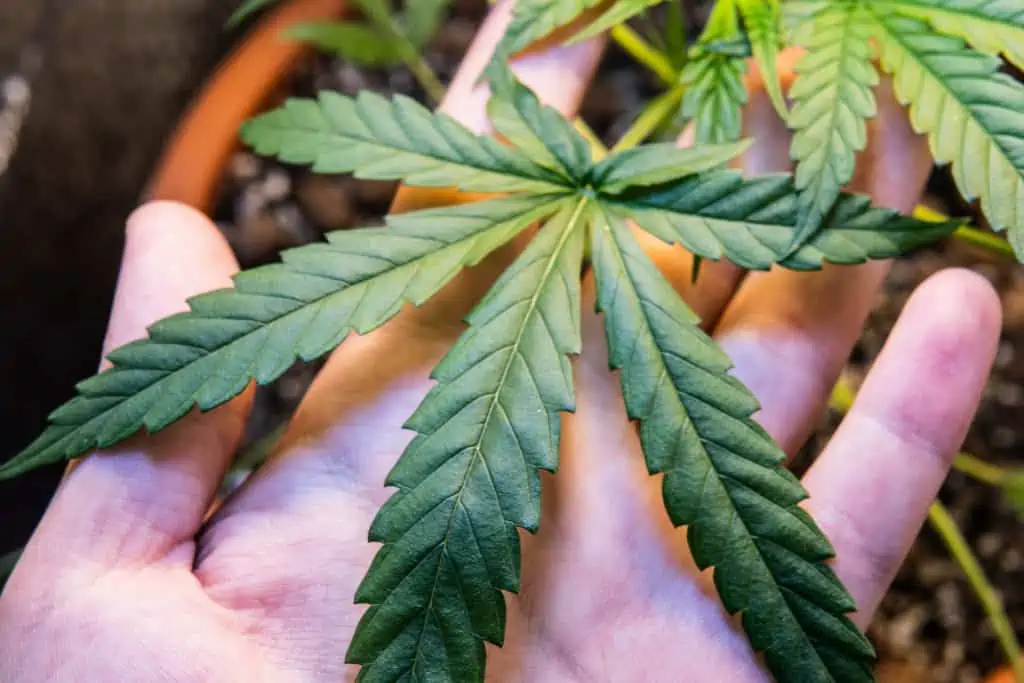
How Hard Is it to Grow Weed ?
Under the right conditions, growing weed is not hard at all. If you live in a state that allows you to grow weed and you're growing a relatively low-maintenance strain, growing weed can be easier than expected. However, some strains are more finicky than others.
How Much Does It Cost to Grow Weed?
If you plan to grow one weed plant, you can end up spending a few hundred dollars for a grow tent, grow lights, nutrients, pots, energy use, and other cultivation essentials. There are many ways you can cut down on costs without sacrificing too much bud quality.
How Many Seeds Do You Need to Grow Weed ?
Can you grow weed with one seed? Technically, you can grow weed from just one seed, although this seed has to be healthy and it should grow under perfect environmental conditions.
If you're starting from regular cannabis seeds, we recommend doubling the amount of seeds you plant depending on how many plants you want. If you're growing from feminized seeds and have a small garden, we recommend planting at least one seed extra for good measure.
How Fast Can You Grow Weed ?
Cannabis plants can fully mature from seeds in as little as 2 months. You can speed up the growth process by starting from clones, choosing fast-growing genetics, growing autoflowering plants, and other quick-growing techniques.
Can You Grow Weed In the Winter ?
What is the best soil for growing weed?
Well-draining, nutrient-rich, and slightly acidic to neutral (6.0-7.0) soil grows weeds well. For best growth, use coco coir, peat moss, compost, perlite, and vermiculite.
How much light do weed plants need?
Weed plants need 18-24 hours of light per day during vegetative growth and 12 hours for flowering. Indoor lighting is usually provided by high-quality full-spectrum LED or HPS lights.
How often should I water my weed plants?
Plant size, growing medium, and environment determine watering frequency. Generally, water when the top inch of soil seems dry. Avoid overwatering to prevent root rot.
What nutrients do weed plants need?
Nitrogen, phosphorus, and potassium are the most critical nutrients for weeds. more nitrogen is better during vegetative growth, but more phosphorus and potassium are better during blooming.
When is the right time to harvest weed?
When to harvest varies on the strain and potency preference. Harvesting occurs when most bud trichomes are hazy white with amber. Checking trichome color with a magnifying glass can help identify harvest time.
How can I increase the yield of my weed plants?
To enhance productivity, try topping or FIMing to create additional bud sites, utilizing right fertilizers, regulating lighting, giving each plant enough room, and keeping perfect environmental conditions.
How do I deal with pests and diseases in my weed garden?
Prevention is crucial for pest and disease control. Clean your grow area, check your plants, and apply natural pest control like neem oil, beneficial insects, or insecticidal soaps. Maintain airflow and avoid overwatering for illnesses.
What's the difference between growing weed in soil vs. hydroponically?
Growing in soil is easier and cheaper for beginners. Hydroponic farming uses a water-based, nutrient-rich solution to grow plants faster and generate more, but it requires more equipment and skill.
Is growing weed easy to do?
Weed cultivated on soil has a higher flavor and scent. And no, it's not difficult to grow; just plant your (favorite) strain in the ground and get started. Clearly. Though there are many different kinds of soil, starting with good quality potting soil will be an easy and quick process.
What is a good strain for first time growers to grow?
Regarded as one of the most well-liked strains, Blue Dream is a popular choice for cannabis fans and a fantastic place for producers to start. It can withstand a variety of temperatures, humidity levels, and light levels and has comparatively little care requirements.
What is the cheapest method to grow your own cannabis?
The least expensive approach is soil, which can yield marijuana that is on par with other varieties. You can go ‘organic' and save money on expensive feed by composting or creating your own compost tea recipe for nutrients.
How much weed does a single plant grow?
The size of a plant is influenced by a variety of factors, but in general, a healthy plant should produce the following yields from one weed plant: Outdoor plant: approximately 224g, or ½ pound, of buds. Indoor plant: approximately 112g, or ¼ pound, of buds.
Where can I learn how to grow weed online?
Learn how to grow weed at Cannabis Training University.
Learn How to Grow Marijuana Plants at CTU
Growing marijuana indoors for the first time takes time, patience, and practice. Enrolling in Cannabis Training University’s accredited online expert training can give you the skills and knowledge you need to start your own cannabis garden at home.
Learn everything about growing indoors, from germinating cannabis seeds to harvesting marijuana plants at the right time. Our curriculum provides you with HD videos, ebooks, quizzes, and more to help you grow your own weed from home.

Luis Cordova
Luis Cordova is a distinguished author, and renowned expert in cannabis cultivation, who possesses a Master's degree in Plant Biotechnology and Pharmaceutical Science. As a valued contributor to highly esteemed publications such as Cannabis Training University and Maximum Yield Magazine, Luis has emerged as a trusted source of guidance and knowledge in the cannabis industry. Having written thousands of informative articles, Luis is widely recognized for his comprehensive expertise on cultivating cannabis, both indoors and outdoors.


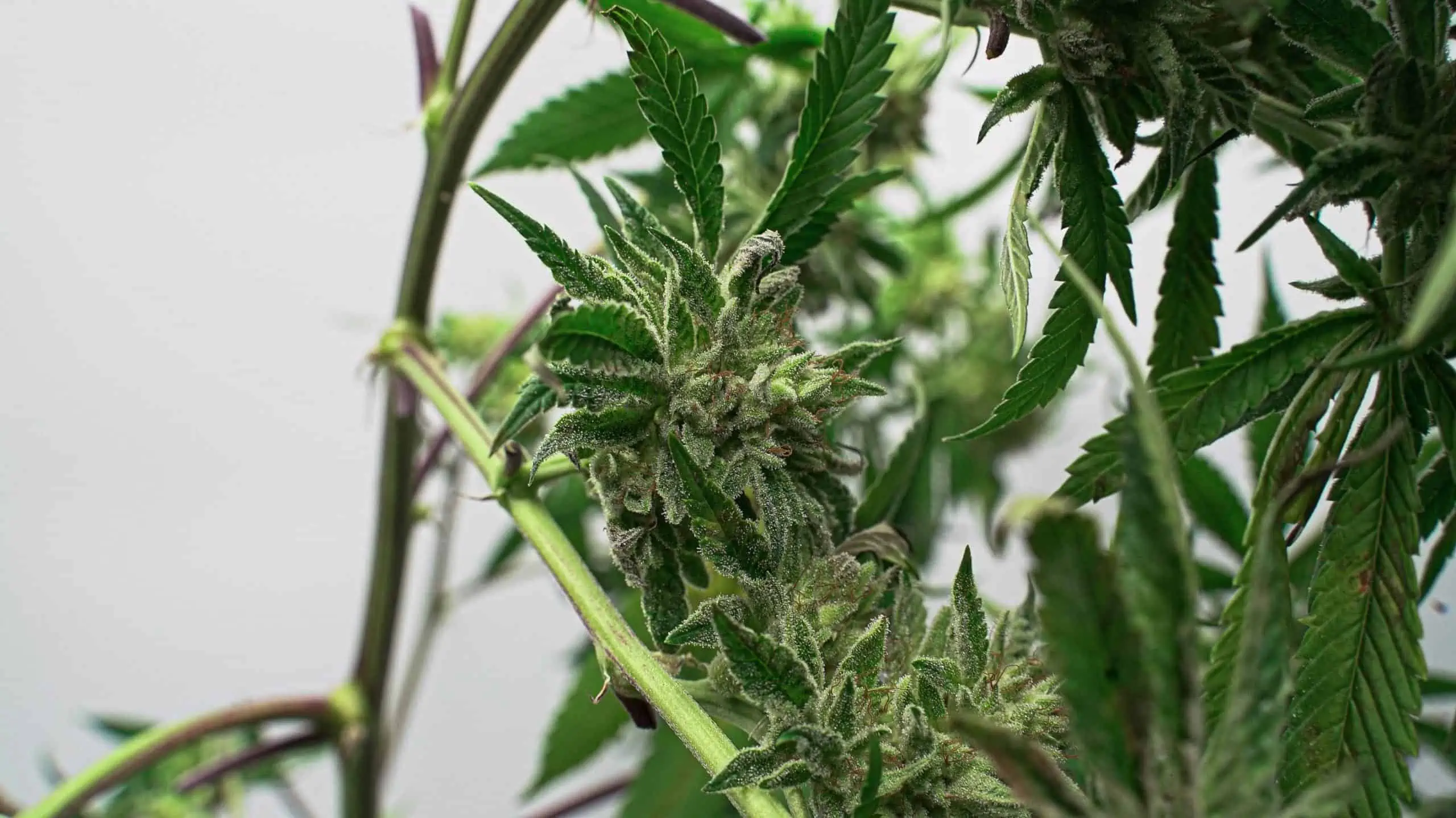





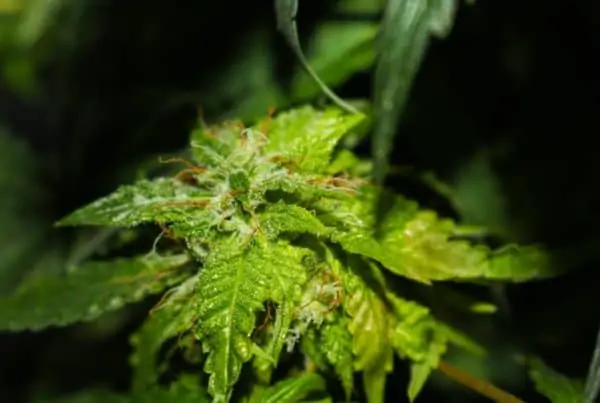
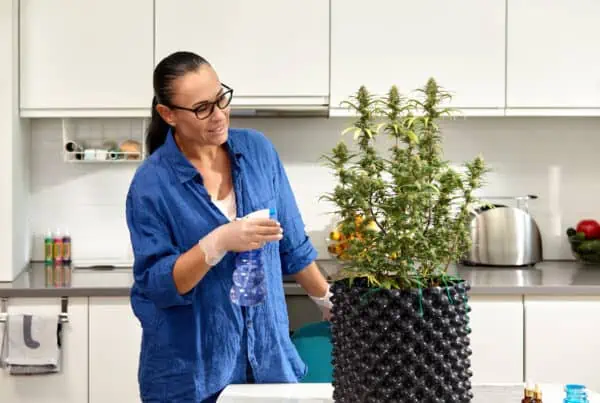
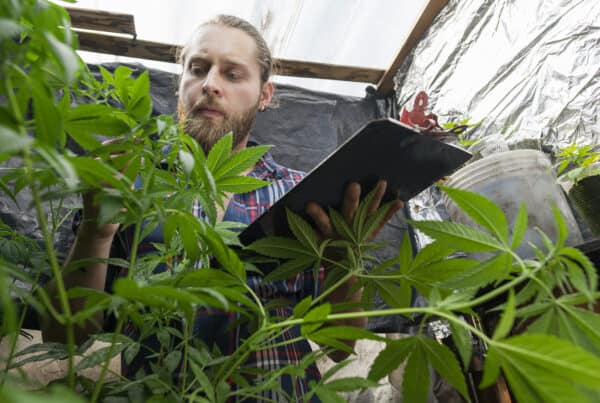

 Jeff was involved in an accident where he endured a traumatic brain injury. He had a week-long stay in ICU where brain surgeons
Jeff was involved in an accident where he endured a traumatic brain injury. He had a week-long stay in ICU where brain surgeons  100% risk free money back guarantee within 48 hours after purchase if student has not completed any of the courses or exams.
100% risk free money back guarantee within 48 hours after purchase if student has not completed any of the courses or exams.